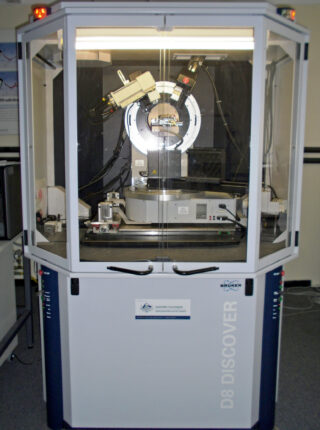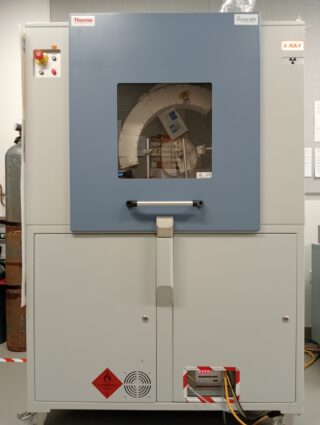X-Ray Diffraction and Scattering Facility
The X-Ray Diffraction and Scattering Facility (XRDSF) was established in 2002, and currently comprises two conventional X-ray diffractometers, an in situ X-ray diffractometer, a small-angle X-ray scattering instrument, and associated sample preparation facilities.
The facilities are available for use by researchers and commercial companies alike. Training in analysis techniques can also be provided, as well as reporting and consultancy.
Techniques and Applications
- Crystalline phase identification and quantification
- Amorphous material determination
- Crystallite size analysis
- Clay determination
- Powder/solid and solution sample preparation available
- Investigation of phase transitions as function of temperature
- Determination of crystallite size

D8 ADVANCE XRD
The Bruker D8A is a Bragg-Brentano geometry X-ray Diffractometer (XRD) with a copper X-ray source and an automated 90 position sample changer. It features a LYNXEYE XE-T position sensitive detector that is 450 times faster than a conventional scintillator detector, allowing for the collection of superior data in a short timeframe. This instrument is used for the majority of X-ray diffraction measurements.

D8 DISCOVER XRD
The Bruker D8D is a Bragg-Brentano geometry X-ray Diffractometer (XRD) with a cobalt X-ray source and automated 10 position sample changer. The cobalt source allows this instrument to accurately analyse high iron content samples such as iron ores.

In-situ X-ray diffractometer
The Thermo Scientific™ ARL™ EQUINOX 5000 is a multi-purpose X-ray diffractometer designed specifically for high level research applications. The system utilizes a unique tall vertical goniometer in θ/θ or θ/2θ mode and the user has a large choice of features including higher resolution detectors and a large choice of X-ray sources. The free space in the sample compartment is very large and will accommodate practically any sample and any sample handling device including furnaces, auto samplers, and large assemblies.
- Uses parallel beam, Cu X-Ray tube.
- Diffraction data collection for in-situ XRD is available over a wide range of temperatures (Hot air blower: 25 to 750 °C, Anton Paar HTK 1200N oven: 25 to 1,200 °C).
- Investigation of phase transition and lattice parameters as a function of temperature.
- Curved Position Sensitive X-ray Detector, CPS 120 (Acquisition in real time over 120° 2Theta).
